Traveling The ‘Road To Joy’ In Letters

During our forced solitude this past year, letter-writing has enjoyed a much-deserved renaissance. Perhaps the next best thing to receiving a newsy, well-written letter from someone we know is to read the published correspondence of history’s great letter-writers.
I’ve spent the past months “receiving” letters from someone I can only wish I had met in person, the great spirituality writer Thomas Merton.
On January 31 — Merton’s 106th birthday — I’ll be reading from some of his letters at an online fundraising event for the International Thomas Merton Society.
Merton was one of the world’s most prolific letter writers. He considered letter-writing his “apostolate of friendship” and sent out more than 10,000 missives to some 1,200 correspondents.

Merton’s letter-writing inspired me to undertake a years’ long correspondence of my own with Brother Paul Quenon, a Trappist monk from the Abbey of Gethsemani, who was a novice during Merton’s time there.
The letters to and from Brother Paul, on topics both spiritual and practical, form the basis of a new book coming out this November from Hampton Roads Publishers, called “How To Be: A Monk & A Journalist Reflect on Living & Dying, Purpose & Prayer, Friendship & Forgiveness.”
(I’ll share more about the new book as the publication date nears).
Merton’s corresponded with a variety of well-known people — including Pope John XXIII, Dorothy Day, Ethel and Jacqueline Kennedy, Paul Tillich, Boris Pasternak and Czeslaw Milosz, among others.
Most fascinating to me, though, are the letters he wrote to the far less well-known, including students, Catholic sisters, readers of his books. In short, people like you and me.

In June 1967, Merton began a lively exchange with a 16-year-old high school student from California named Suzanne Butorovich. She wrote asking him to contribute an article to her school’s underground newspaper. And Merton agrees!
He offers her a prose-poem called “Prayer to a Computer” that begins:
Write a prayer to a computer? First of all you have
to find out how It thinks. Does it dig prayer?
Merton likens the poem to Bob Dylan’s work and tells Suzanne “I love Bobby D … I have lots of his stuff.”
When Suzanne offers to educate the 52-year-old monk on pop culture, he responds, “What do you think I am, six hundred years old or something, that I don’t know Paul McCartney is a Beatle? I have their record of Revolver — only one I have. I like them fine.”
And so it goes, prompting Suzanne to dub Merton in a subsequent letter, the “Hippie Hermit.”
Though Merton is frequently fun-loving, he is just as often thoughtful, even tender. In June of 1968, when Suzanne sends him her yearbook photo, he writes back on a piece of recycled writing paper with the letterhead, “Action Study on Community Health Care:”
“Don’t mind the letterhead, this is just the secret headquarters of my drug pushing outfit (aspirins, et cetera). I was very happy to get your graduation picture. You have grown into a very charming and interesting young woman … I was remembering you at Mass on Saturday. Go forth into the wide world and help it make some kind of sense. Or anyway less nonsense.”
Would that I had received that same advice when I graduated from my high school, the Academy of St. Aloysius!
Within six months of Suzanne’s graduation, Merton was dead at the age of 53, accidentally electrocuted after touching the faulty wiring of a fan in the cottage where he was staying at a conference on Buddhist and Christian monasticism in Bangkok.
More than five decades later, Suzanne’s eyes still light up remembering her friendship with the monk she calls “Tom.” In Morgan Atkinson’s 2015 documentary, “The Many Storeys and Last Days of Thomas Merton,” she says Merton is the kind of person who could never be old. “He would be hip at 95.”

One of Merton’s most moving letters is not to a young person, but about one. In 1963, he wrote to Chris McNair of Alabama, whose 11-year-old daughter, Carol Denise, was one of four young girls killed in the bombing of Birmingham’s 16th Street Baptist Church.
Merton saw a photograph in Look magazine of Carol Denise holding one of her dolls and was so moved, he cut it out and kept it. It inspired his poem, “Picture of a Black Child with A White Doll.” To Carol Denise’s father, he wrote:
“Carol Denise is not forgotten on this earth. She remains as a witness to innocence and love and an inspiration to all of us who remain to face the labor, the difficulty and the heartbreak of the struggle for human rights and dignity.”

I can only imagine the effort it took for Merton in his rural Louisville monastery to track down the McNair family’s address in the days before Google searches or whitepages.com.
The letter also causes me to wonder if there is a single American Catholic leader today with the authenticity or gravitas of Merton who could write a letter like that to, say, George Floyd’s relatives or those of Breonna Taylor, gunned down by police last year not too far from Merton’s monastery.
Something to think about.
Both the McNair and Butorovich letters are in a collection called “The Road to Joy,” one of 12 volumes of Merton’s correspondence. The title comes from a drawing Merton received from 10-year-old Grace Sisson, whose father was a peace activist and friend of his.
Grace called the path in her drawing, “the road to joy.” The phrase leapt out at Merton.

He wrote to Grace, “I am glad you still draw things with love, and I hope you will never lose that. But I hope you and I together will secretly travel our own road to joy, which is mysteriously revealed to us without our exactly realizing it.”

Reading Merton’s letters — and initiating my own correspondence decades later with Brother Paul Quenon — has been like traveling a literary road to joy. The poet Willie Perdomo has called letter-writing our “resistance against loneliness,” and that is what these exchanges have turned out to be.
I encourage you to begin a correspondence with someone you admire — perhaps a trusted friend, or someone you’d like to have as a spiritual director. Like Merton, begin your own “apostolate of friendship” today.









